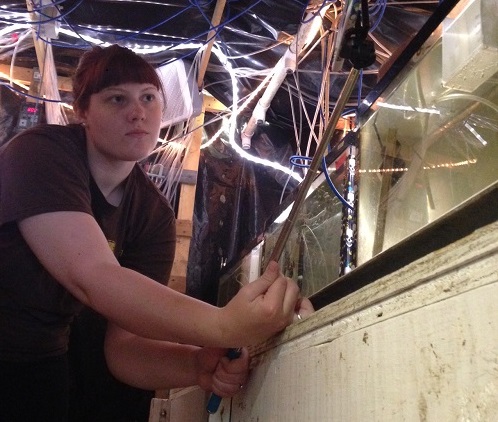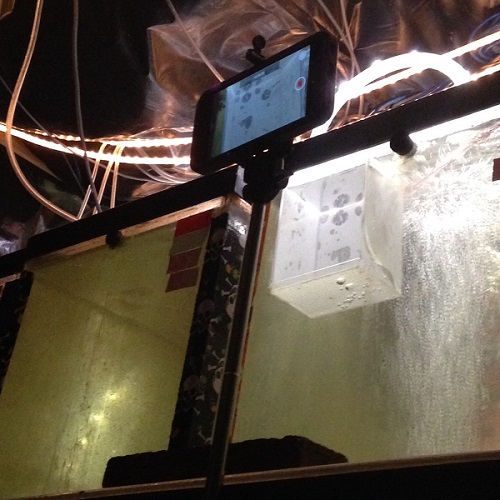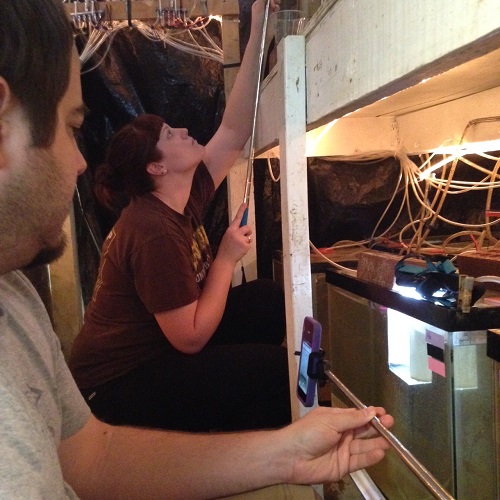by Chris Patrick
Lovers of both the Smithsonian and the selfie stick, rejoice! Though the infamous monopods are banned in Smithsonian museums and galleries, they’ve found a new arena of use: labs.
Well, in one lab at least. Researchers in the marine ecology lab at the Smithsonian Environmental Research Center (SERC) are using selfie sticks to record fish behavior without scaring them. SERC’s marine ecology team wants to see if fish raised in low-oxygen conditions acclimate to breathing less oxygen. “I have never heard of someone else using the selfie stick for science,” said Seth Miller, a postdoctoral fellow in the marine ecology lab and collaborator on the project. “Although it probably occurs. Ecologists are pretty resourceful.”
The team initially tried to simply watch the fish, but found the Atlantic silversides would “freak out” as Miller described it, moving around all crazy-like when they put their faces near the tanks. This is not an ideal scenario when trying to count the number of times a tiny fish beats its even tinier gill flaps as it breathes.
First, the team raised juvenile fish for three weeks in constant conditions: some at normal oxygen and some at low oxygen. Then they gradually lowered the oxygen for all the fish, beginning at 100 percent oxygen saturation (normal oxygen levels), and stepping down the oxygen every 15 minutes—to 75 percent, 50 percent, 25 percent, and 15 percent. When a fish is in low-oxygen conditions, its gill flaps beat faster—the same way humans breathe harder when there’s not enough oxygen.
Miller wants to see if fish raised for three weeks at low oxygen levels don’t breathe as hard in low-oxygen conditions compared to fish who weren’t exposed to low oxygen levels. This would indicate the fish raised in low oxygen had acclimated to these conditions and are now better at handling it.
He likened it to Tibetans who have lived at high altitudes for thousands of years. “The Tibetan people have actually evolved greater lung capacity because it serves them well in that low-oxygen environment,” said Miller. “And we’re sort of looking at the same thing in fish.”
If individual fish can acclimate to low-oxygen conditions in a short period of time, over a longer period entire populations may be able to adapt to them. Some areas of Chesapeake Bay contain less oxygen than they used to.
As global temperature increases, these low-oxygen areas will expand and lose even more oxygen. “If these fish can’t adjust,” said Miller, “they’re going to be pushed out of those areas and lose that habitat.”
But it’s not so easy to count the number of times a startled fish beats its gill flaps in real-time as it swims in unpredictable bursts of panicked movement.
“It’s basically impossible,” Miller said. So instead of just staring into the tank, the team started recording video on their phones while holding them in their hands. But this seemed to startle the fish as well. Eventually Rebecca Burrell, the lab’s head technician, suggested selfie sticks. Technician Ashley Collier went to Five Below and bought the lab five of them.
Now the crew sits, crouches, or stands on the lab’s “boardwalks,” a series of elevated walkways between stacked rows of tanks, with their selfie sticks in hand. The extendable monopods lengthen the reach of their arms, allowing their mounted phones to be against the glass without any faces or hands in a fish’s view. For about two minutes, they’ll record a single fish corralled into a small box lit by a headlamp resting on top of the tank. Once they’ve recorded enough of their subject, the team downloads the film onto the computer, slows the footage down, and counts the number of times the fish beat their gill flaps per minute. It’s a much easier, and trendier, way to watch fish breathe.
But like any plan involving cell phones, the system isn’t entirely without glitches. During one filming session, Miller reached up to repeatedly tap the screen of his smartphone with an impatient finger and sternly coaxed, “Come on, focus! Phooone!” Even selfie sticks present challenges in the lab—though they probably won’t be banned from science anytime soon.




